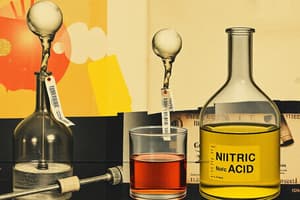Podcast
Questions and Answers
During the laboratory preparation of nitric acid, which of the following sets of reactants is commonly used?
During the laboratory preparation of nitric acid, which of the following sets of reactants is commonly used?
- Sulfuric acid and potassium nitrate (correct)
- Acetic acid and sodium bicarbonate
- Phosphoric acid and calcium carbonate
- Hydrochloric acid and sodium chloride
What observation would indicate that a sample of nitric acid is undergoing decomposition?
What observation would indicate that a sample of nitric acid is undergoing decomposition?
- Increase in pH
- Evolution of a brown gas (correct)
- Formation of a white precipitate
- Decrease in temperature
A metal 'M' reacts with dilute nitric acid to form $M(NO_3)_2$, water, and nitric oxide (NO). Which of the following metals could be 'M'?
A metal 'M' reacts with dilute nitric acid to form $M(NO_3)_2$, water, and nitric oxide (NO). Which of the following metals could be 'M'?
- Copper (Cu) (correct)
- Silver (Ag)
- Platinum (Pt)
- Gold (Au)
Which of the following reactions demonstrates nitric acid acting as an oxidizing agent?
Which of the following reactions demonstrates nitric acid acting as an oxidizing agent?
Aqua regia, a mixture of nitric acid and hydrochloric acid, is used to dissolve noble metals. What is the active component responsible for dissolving these metals?
Aqua regia, a mixture of nitric acid and hydrochloric acid, is used to dissolve noble metals. What is the active component responsible for dissolving these metals?
A solution of nitric acid is added to a sample of an unknown substance. The substance dissolves, and bubbles of carbon dioxide are released. What type of substance was likely in the sample?
A solution of nitric acid is added to a sample of an unknown substance. The substance dissolves, and bubbles of carbon dioxide are released. What type of substance was likely in the sample?
Which of the following statements accurately describes a key physical property of pure nitric acid?
Which of the following statements accurately describes a key physical property of pure nitric acid?
Why is nitric acid used in the preparation of fertilizers like calcium nitrate [$Ca(NO_3)_2$] and ammonium nitrate [$NH_4NO_3$]?
Why is nitric acid used in the preparation of fertilizers like calcium nitrate [$Ca(NO_3)_2$] and ammonium nitrate [$NH_4NO_3$]?
Flashcards
Nitric Acid Formula
Nitric Acid Formula
HNO3, a strong acid.
HNO3 Ionization
HNO3 Ionization
It ionizes almost completely in water: HNO3 -> H+ + NO3-
HNO3 Decomposition
HNO3 Decomposition
Unstable, decomposes in sunlight: 4HNO3 -> 4NO2 + 2H2O + O2
Lab Preparation of HNO3
Lab Preparation of HNO3
Signup and view all the flashcards
HNO3 with Carbonates
HNO3 with Carbonates
Signup and view all the flashcards
Uses of HNO3
Uses of HNO3
Signup and view all the flashcards
Aqua Regia
Aqua Regia
Signup and view all the flashcards
HNO3 as Oxidizer
HNO3 as Oxidizer
Signup and view all the flashcards
Study Notes
- Nitric Acid has a molecular formula of HNO3
- Nitric Acid has a relative molecular mass of 63
Laboratory Preparation of Nitric Acid
- KNO3 reacts with H2SO4 at under 200°C to yield KHSO4 and HNO3
- NaNO3 reacts with H2SO4 at under 200°C to yield NaHSO4 + HNO3
Physical Properties of Nitric Acid
- Pure nitric acid (98% conc.) is colorless with an suffocating and sour taste.
- Nitric acid is heavier than water, with a specific gravity of 1.54
- The boiling point of nitric acid is 86°C
- The freezing point of nitric acid is −42°C
Chemical Properties of Nitric Acid
- Pure nitric acid is colorless, unstable, and decomposes slightly at room temperature and in sunlight
- 4HNO3 → 4NO2 + 2H2O + O2
- Nitric acid is a very strong monobasic acid
- It ionizes almost completely in aqueous solution : HNO3 → H+ + NO3-
- Nitric acid neutralizes alkalis to form salt and water
- CaO + 2HNO3 → Ca(NO3)2 + H2O
- CuO + 2HNO3 → Cu(NO3)2 + H₂O
- NaOH + HNO3 → NaNO3 + H2O
- Nitric acid reacts with carbonates and bicarbonates to produce salt, water, and carbon dioxide
- Na2CO3 + 2HNO3 → 2NaNO3 + H2O + CO2
- NaHCO3 + HNO3 → NaNO3 + H2O + CO2
- Carbon, sulphur, and phosphorus are oxidizes by nitric acid to their highest oxides or oxy-acids such as carbon dioxide, sulphuric acid, and phosphoric acid
- C + 4HNO3 → 2H2O + 4NO2 + CO2
- S + 6HNO3 → H2SO4 + 2H2O + 6NO2
- P₄ + 20HNO3 → 4H3PO4 + 4H2O + 20NO2
- Cold and dilute nitric acid oxidizes metals to their nitrates and liberates nitric oxide
- 3Cu + 8HNO3 → Cu(NO3)2 + 2H2O + 2NO2
- 3Zn + 8HNO3 → 3Zn (NO3)2 + 4H2O + 2NO2
- Concentrated nitric acid liberates nitrogen dioxide
- Cu + 4HNO3 → Cu(NO3)2 + 2H2O + 2NO2
- Zn + 4HNO3 → Zn (NO3)2 + 2H2O + 2NO2
- Nitric acid (1 part by volume) mixed with conc. hydrochloric acid (3 parts by volume) produces aqua regia
- HNO3 + 3HCl → NOCl + 2H2O + 2[Cl]
- Aqua regia contains nascent chlorine and reacts with noble metals such as gold and platinum to produce chlorides
- Pt + 4[Cl] - → PtCl4
- Au +3[Cl] → AuCl3
Uses of Nitric Acid
- Used to etch designs on copper and brassware as it acts as a solvent for several metals except the noble metals
- Used to purify gold with impurities of Cu, Ag and Zn which dissolve in nitric acid
- Nitric acid acts as a rocket fuel oxidant
- Used in the preparation of fertilisers such as Ca(NO3)2 and NH4NO3
- Used in the preparation of aqua regia, which dissolves noble metals
Studying That Suits You
Use AI to generate personalized quizzes and flashcards to suit your learning preferences.




